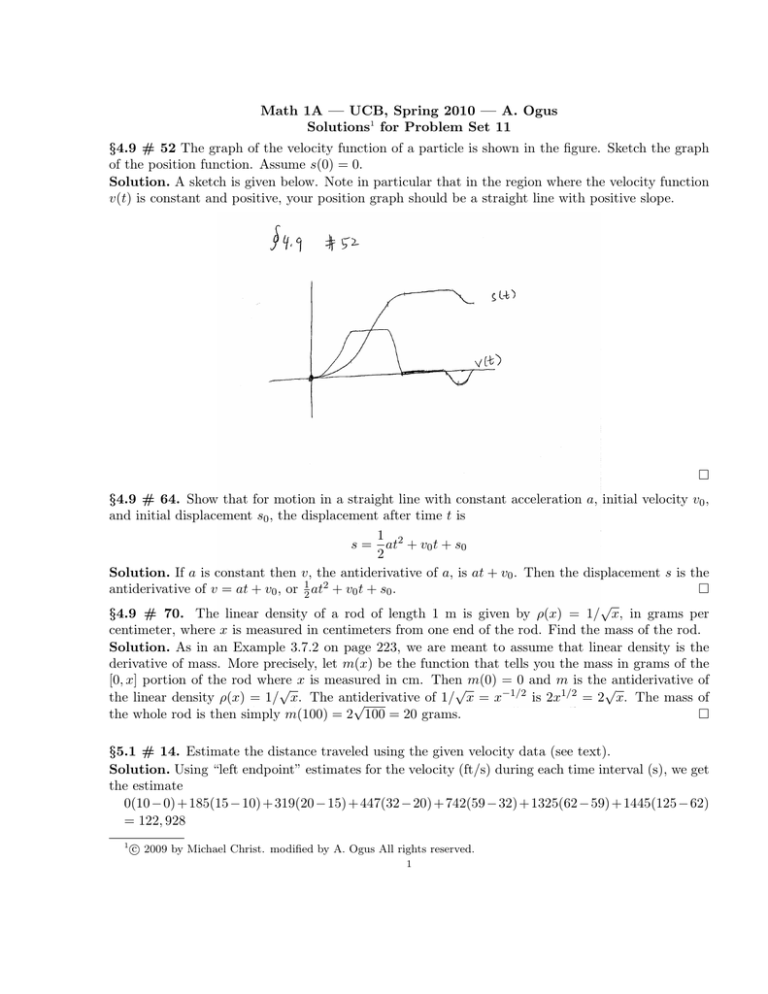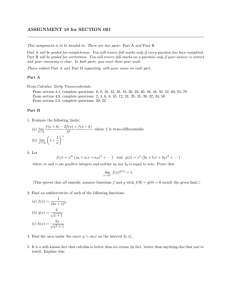
Math 1A — UCB, Spring 2010 — A. Ogus
Solutions1 for Problem Set 11
§4.9 # 52 The graph of the velocity function of a particle is shown in the figure. Sketch the graph
of the position function. Assume s(0) = 0.
Solution. A sketch is given below. Note in particular that in the region where the velocity function
v(t) is constant and positive, your position graph should be a straight line with positive slope.
§4.9 # 64. Show that for motion in a straight line with constant acceleration a, initial velocity v0 ,
and initial displacement s0 , the displacement after time t is
1
s = at2 + v0 t + s0
2
Solution. If a is constant then v, the antiderivative of a, is at + v0 . Then the displacement s is the
antiderivative of v = at + v0 , or 21 at2 + v0 t + s0 .
√
§4.9 # 70. The linear density of a rod of length 1 m is given by ρ(x) = 1/ x, in grams per
centimeter, where x is measured in centimeters from one end of the rod. Find the mass of the rod.
Solution. As in an Example 3.7.2 on page 223, we are meant to assume that linear density is the
derivative of mass. More precisely, let m(x) be the function that tells you the mass in grams of the
[0, x] portion of the rod where x is measured in cm. Then m(0) = 0 and m is the antiderivative of
√
√
√
the linear density ρ(x) = 1/ x. The antiderivative
of 1/ x = x−1/2 is 2x1/2 = 2 x. The mass of
√
the whole rod is then simply m(100) = 2 100 = 20 grams.
§5.1 # 14. Estimate the distance traveled using the given velocity data (see text).
Solution. Using “left endpoint” estimates for the velocity (ft/s) during each time interval (s), we get
the estimate
0(10 − 0) + 185(15 − 10) + 319(20 − 15) + 447(32 − 20) + 742(59 − 32) + 1325(62 − 59) + 1445(125 − 62)
= 122, 928
1
c 2009 by Michael Christ. modified by A. Ogus All rights reserved.
1
Alternatively, using “right endpoint” velocity estimates, we’d get:
185(10−0)+319(15−10)+447(20−15)+742(32−20)+1325(59−32)+1445(62−59)+4151(125−62)
= 316, 207
§5.1 # 18. Write an expression using “Definition 2” defining the area under the graph of the function
f (x) = ln(x)/x as a limit.
Solution. Recall from p. 360 that this definition uses “right endpoints”, so the expression is:
lim
n→∞
n
X
f (xi )∆x =
lim
n→∞
i=1
n
X
i=1
i
1
f (3 + (10 − 3) ) ·
n n
n
X
ln((3n + 7i)/n) 1
= lim
·
n→∞
(3n + 7i)/n
n
i=1
=
lim
n→∞
n
X
ln(3n + 7i) − ln(n)
3n + 7i
i=1
§5.1 # 20. Determine a region whose area is equal to:
n
X
2i 10
2
lim
5+
n→∞
n
n
i=1
Solution. This is a “right endpoint” computation of the area under the graph of f (x) = x10 between
2i
x = 5 and x = 7 (so then n2 = 5−7
n = ∆x and 5 + n = xi ).
§5.1 # 26. a) Let An be the area of a polygon with n equal sides inscribed in a circle of radius r.
Divide the polygon into n congruent triangles with central angle 2π/n so show that
1
An = nr2 sin
2
2π
n
b) Show that limn→∞ An = πr2
Solution. a) The area of a triangle having sides of lengths a,b with an angle θ between them is
2π
1
2 ab sin θ. Here each triangle has a = b = r and angle θ = n , and there are n of them, so the total
area is
n·
1
r · r sin
2
2π
n
1
= nr2 sin
2
2π
n
b) Instead of the hint, which involves using a substitution (e.g. x = 2π/n), we can use l’Hospital’s
rule (thinking of n as a continuous variable):
2
1
lim nr2 sin
n→∞ 2
2π
n
=
=
=
=
1 2
sin(2π/n)
r lim
2 n→∞
1/n
1 2
cos(2π/n)(−2π/n2 )
r lim
2 n→∞
−1/n2
1 2
cos(2π/n)(−2π)
r lim
n→∞
2
−1
1 2 (1)(−2π)
r
= πr2
2
−1
R4
§5.2 # 22. Use “Theorem 4” to evaluate 1 (x2 + 2x − 5)dx.
Solution. This theorem uses “right endpoints”:
Z
1
4
n
X
4−1 4−1
(x + 2x − 5)dx = lim
f 1+
i
n→∞
n
n
2
=
lim
n→∞
i=1
n
X
f (1 +
i=1
3 3
i)
n n
n
=
n + 3i
3 X n + 3i 2
(
) + 2(
)−5
n→∞ n
n
n
lim
i=1
n
3 X 9i2 + 12ni − 2n2
= lim
n→∞ n
n2
i=1
3
= lim 3
n→∞ n
=
=
=
=
=
n
n
n
X
X
X
9(
i2 ) + 12n(
i) − (
2n2 )
i=1
i=1
!
i=1
3
n(n + 1)(2n + 1)
n(n + 1)
2
lim
9
) + 12n
− n · 2n
n→∞ n3
6
2
3n3 + 6n3 − 2n3 + smaller powers
3 lim
n→∞
n3
7n3 + smaller powers
3 lim
n→∞
n3
3·7
21
R 10
§5.2 # 30. Express 1 (x − 4 ln x) as a limit of Riemann sums (do not evaluate).
Solution. Using “right endpoint” sums, we get:
3
10
Z
1
n X
10 − 1
10 − 1
10 − 1
(1 +
(x − 4 ln x) = lim
i) − 4 ln(1 +
i)
n→∞
n
n
n
i=1
n X
9
9
9
(1 + i) − 4 ln(1 + i)
= lim
n→∞
n
n
n
i=1
§5.2 # 34c. Use the graph (in text) to evaluate the integral
Solution.
Z
7
Z
g(x)dx =
2
Z
0
g(x)dx
6
g(x)dx +
0
R7
Z
g(x)dx +
0
2
7
g(x)dx
6
= triangle1 + semicircle + triangle2
1
1
=
(2)(4) + π(2)2 + (1)(1)
2
2
9
=
+ 4π
2
R5
R5
§5.2 # 48. If 1 f (x)dx = 12 and 4 f (x)dx = 3.6, find
Solution.
R5
R5
R4
1 f (x)dx = 1 f (x)dx - 4 f (x)dx = 12- 3.6=8.4.
R4
1
f (x)dx.
§5.2 # 51. Suppose fR has an absolute minimum value m and absolute maximum value M . Between
2
what two values must 0 f (x)dx lie? Which property of integrals allows you to make your conclusion?
Solution.
R2
0 f (x)dx must lie between 2m and 2M by Property 8.
R 2 −x
§5.2 # 59. Use Property 8 to estimate 0 xe dx.
Solution.
The absolute minimum value of xe−x on [0, 2] is 0. The absolute maximum value of xe−x on [0, 2]
R2
is 1/e. Apply property 8, we get 0 ≤ 0 xe−x dx ≤ 2/e.
§5.2 # 65. If f is continuous on [a, b], show that
Z b
Z b
|
f (x)dx| ≤
|f (x)|dx.
a
a
Solution.
From −|f (x)| ≤ f (x) ≤ |f (x)| and Property 7, we get
Z b
Z b
Z b
−
|f (x)|dx ≤
f (x)dx ≤
|f (x)|dx.
a
a
a
4
So
Z
b
Z
b
|f (x)|dx.
f (x)dx| ≤
|
a
a
§5.2 # 68. Let f (0) = 0 and f (x) = 1/x if 0 < x ≤ 1. Show that f is not integrable on [0, 1].
Solution. Recall that in the of definite integral (Page 366), we divided the interval [0, 1] into n
subintervals of equal length 1/n. Then the first term in the Riemann sum, f (x1 )/n = 1/(x1 n) can
be made arbitrary large by making x1 arbitrarily close to 0. So the limit does not exist. (or one can
say that the limit is not a finite number.) So f is not integrable on [0, 1].
# 9. Use Part 1 of the Fundamental Theorem of Calculus to find the derivative of g(y) =
R§5.3
y 2
t
sintdt.
2
Solution.
By Part 1 of the Fundamental Theorem of Calculus, g 0 (y) = y 2 siny.
§5.3
Use Part 1 of the Fundamental Theorem of Calculus to find the derivative of y =
R cosx # 16.
2 )10 dv.
(1
+
v
1
Solution.
Rx
Let g(x) = 1 (1 + v 2 )10 dv, then y = g(cosx), apply the chain rule, y 0 = g 0 (cosx)(−sinx). By Part
1 of the Fundamental Theorem of Calculus, g 0 (cosx) = (1 + cos2 x)10 . Finally,
y 0 = g 0 (cosx)(−sinx) = (1 + cos2 x)10 (−sinx)
R1
§5.3 # 23. Evaluate 0 x4/5 dx.
Solution.
R1
By Part 2 of the Fundamental Theorem of Calculus, 0 x4/5 dx = 95 x9/5 ]10 = 59 .
R π/4
§5.3 # 31. Evaluate 0 sec2 tdt.
Solution.
R π/4
π/4
By Part 2 of the Fundamental Theorem of Calculus, 0 sec2 tdt = tanx]0 = tan(π/4) − tan0 =
1.
R2 4
§5.3 # 44. What is wrong withe equation −1 x3 dx = − x22 ]2−1 = 32 .
Solution.
4
is not defined (not integrable, not continuous) over [-1,2]. So one can not apply Part 2 of the
x3
Fundamental Theorem of Calculus.
R2 3
§5.3 # 51 Evaluate the integral −1 x dx and interpret it as a difference of areas. Illustrate with a
graph.
Solution.
5
Apply Part 2 of the Fundamental Theorem of Calculus,
= 15
4 .
R2
−1 x
3 dx
= 14 x4 ]2−1 = 41 24 - 14 (−1)4 = 4- 14
6




